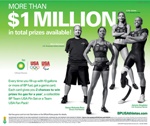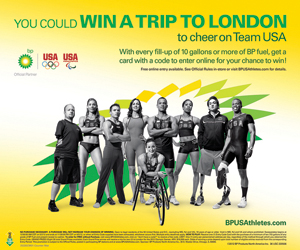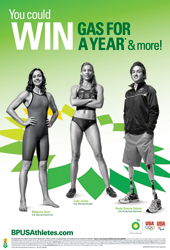When McDonald’s decided to feature Marlon Shirley on cups during the 2004 Athens Games, it signified a breakthrough for the Paralympics. For the first time, one of its stars was being showcased at the restaurant nationwide alongside recognizable Olympians such as gymnast Carly Patterson.
Nearly a decade later, Shirley, the first amputee to break 11 seconds in the 100 meters, is slated to appear in Procter & Gamble campaigns alongside athletes such as swimmer Ryan Lochte and gymnast Jordyn Wieber. But he’s no longer unique. More than a dozen other Paralympians will be showcased this summer in Olympic marketing campaigns by sponsors ranging from BP to Visa and Coca-Cola to 24 Hour Fitness.
“There’s a growing recognition of the awesomeness of Paralympians’ abilities,” said Patrick Quinn of Chicago Sports & Entertainment Partners, who represents Shirley. “Paralympic deals used to be fewer and farther between and not paid as well, but now there’s no question there are more Paralympic deals and they’re growing in compensation and activation.”
Marketing opportunities and exposure for Paralympians has been on the rise since the early 2000s, and Olympic marketers say the
 |
BP is one of several companies tapping into the Paralympics in its advertising, using nearly as many Olympians (five) as Paralympians (four).
|
increasing integration of Paralympians in promotions alongside Olympians ahead of the London Games is a breakthrough that closes the gap in awareness between the Paralympics and the Olympics.
The Paralympic Games will begin in London on Aug. 29 and feature disabled athletes competing in 20 sports over eight days.
This summer offers a series of firsts in the Paralympic space. BP is one of the first sponsors to endorse a nearly equal number of Olympians (five) as Paralympians (four); Coca-Cola will air its first, stand-alone 30-second spot around a Paralympian, swimmer Jessica Long; and 24 Hour Fitness will maintain Olympic advertising, which features Paralympic runner April Holmes, in its facilities through the end of the Paralympic Games in September.
Once a distant afterthought to the Olympics, the Paralympics are clearly on the rise. Research conducted by the U.S. Olympic Committee in 2002 showed that only 5 percent of Americans were aware of the Paralympics. A similar study conducted in March by nonprofit research firm SRI showed that 73 percent of Americans are aware of the Paralympics ahead of the London Games.
The reasons awareness has swelled and sponsors are using Paralympians more include the USOC’s move to change how it sells and promotes the Paralympics, the decade of wars that injured a host of enlisted men and women, and perhaps most important, Paralympians’ stories of overcoming challenges that rival — and in many cases supersede — those of Olympians.
The USOC created a Paralympic office in 2001, but it wasn’t until 2005 that the organization took over management of the governing body for national Paralympic teams. Initially, the USOC focused on developing the infrastructure to manage the U.S. Paralympic team. It later began integrating the U.S. Paralympic rights into its sales package, so that sponsors who sign a deal with the USOC also get U.S. Paralympic rights.
“There was nobody focused on selling or utilizing the Paralympic brand when we started,” said Charlie Huebner, chief of U.S. Paralympics. “It was an undeveloped asset.”
Since taking the U.S. Paralympics under its wing, the USOC has developed more assets around the organization for sponsors. The Warrior Games, which it developed in collaboration with the U.S. armed forces in 2010, is probably the most appealing thing it has developed. The Warrior Games were designed to introduce injured service members to Paralympic sports after they returned from war in Iraq and Afghanistan. Deloitte signed on as a presenting sponsor of the annual event.
“That’s really changed the public perception of Paralympic athletes,” said Heather Novickis, an agent at Octagon who represents Paralympic swimmer Jessica Long. “People are more open and knowledgeable of disabilities and our soldiers now because of what we’ve been through as a country.”
USOC sponsor Deloitte has latched onto the property and become so enthralled with the Paralympics that it regularly hires Paralympians to speak to its staff and clients. The power of stories like Holmes, a college track star who lost her leg boarding a train in Philadelphia and now trains able-bodied runners, puts listeners’ lives in perspective in ways that speeches from a traditional Olympian can’t.
The Hartford, an official sponsor of the U.S. Paralympic team, has become so awestruck by those stories that it hires Paralympians to make 250 appearances a year for customers and clients of its long- and short-term disability insurance. Their appeal onstage was part of what inspired The Hartford to develop two commercials that debuted during the 2010 NCAA men’s basketball championship that featured paralympic swimmer Melissa Stockwell and Paralympic cyclist Sam Kavanagh.
Coca-Cola made a similar decision when it came to its advertising plans around the London Games. Dina Gerson, Coke’s director of Olympic marketing, said the company rarely develops 30-second spots around athletes it signs for the Olympics but found Long’s story so compelling that it wanted to build a spot to showcase her.
“Paralympians are very genuine,” said Gordon Kane, founder of Chicago-based Victory Sports Marketing and a former director of marketing at the USOC. “If you filled a room and said LeBron James and April Holmes are going to speak, people would come to hear LeBron, but I’ll bet you dollars to doughnuts April is the one they’ll remember.”
Sponsors and agents say Paralympians command fewer endorsement dollars than able-bodied athletes, but that the number of opportunities afforded to them is on the rise and so is what sponsors are willing to pay for their services. Where an Olympic gold medalist might earn $10,000 for a corporate appearance, a Paralympian might get a high price of $5,000 to $7,000 because they’re typically willing to work for less and know they’re less recognizable than an Olympic star such as Michael Phelps or Natalie Coughlin.
“The Olympics are such a giant global thing that in order to catch up to them, the Paralympics have a long way to go,” Quinn said. “But I do think it will keep improving, especially as companies continue to look for what is the best investment. There’s huge value to be had in Paralympians.”






